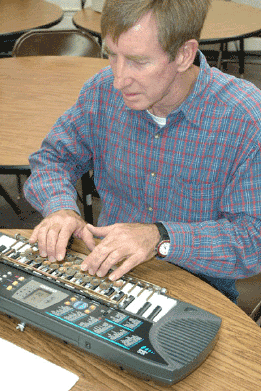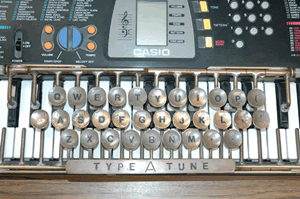
Bruce Burns created the Type-A-Tune to enable those with no musical training to make music. The typewriter keyboard translates keystrokes into tunes on an electronic piano.
Mar 15, 2006–For years, Bruce Burns wanted to play an instrument. After several attempts ended in frustration, the Fredericksburg resident still couldn’t play piano. But he could type. He could type very well.
What if, he asked himself, I could take my typing skills and somehow transfer them to playing music? Instead of typing letters, I could “type a tune,” he reasoned.
Eureka. The Type-A Tune was born.
Burns, who taught Spanish at Fredericksburg High School for 29 years, recently brought his Rube Goldberg contraption from his Bandera retirement retreat. A description won’t do it justice. Just imagine a typewriter keyboard mounted on top of an electronic keyboard. Burns doesn’t know how many hours – or years – it took to put together this intricate construction of copper tubing, soldered joints, and … well.. pennies. That’s right… pennies.
To fashion the typewriter keys, he actually pounded pennies into a concave shape to fit the fingers. He had trouble soldering them to the tubes, until he realized today’s pennies are not all copper. He had to collect enough pre-1960s pennies before he could finish.
Burns made each typewriter key correspond to a note on the piano. Typing the letter “S” for example, strikes “middle C.” The home row on a typewriter works up the scale ending in high C, which, on the Type-A-Tune, is “L.” (Old joke: I used to play in a band where everything sounded like “L.”)
The row above the home row roughly corresponds to the black keys. The bottom row reaches out to play notes above and below the octave.
It is much harder to describe than to use.
To play a song, you simply type the letters, which Burns has conveniently written out next to the musical notes in the sheet music.

Closeup of keyboard
Burns’ Type-A-Tune sits atop an electronic keyboard. Burns designed and built the contraption by soldering together copper tubing and pre-1960s pennies.
Burns demonstrated his invention. The first phrase of Amazing Grace, for example comes out “DH…KHK…J..H..F..D.”
To the person trained in conventional piano theory, the Type-A-Tune may seem unwieldy. A musician is not used to playing notes like “Z,” “Q,” “comma,” and “semicolon.” But, Burns emphasizes, his device is designed for someone who never learned to read music, and never will learn to read music. The Type-A-Tune lets complete novices play a song within minutes.
“If they can type, they can play,” he said proudly.
Burns is so thoroughly immersed in his system, he has transferred the concept to guitar, going so far as charting out the typewriter keyboard to the frets on a guitar. ”I basically type on my guitar,” he explained.
The retired teacher harbors no illusions of financial success or fame.
“There are people like me who just want to play music,” he said. “They’ll buy an expensive instrument, but they may lack the talent, time or ability to learn. I think this bridges that gap. People get frustrated trying to learn. With Type-A-Tune, people don’t give up, because they experience immediate success.”
Euclid was right: There is no royal road to geometry. But Bruce Burns has discovered a “Royal” road to music.